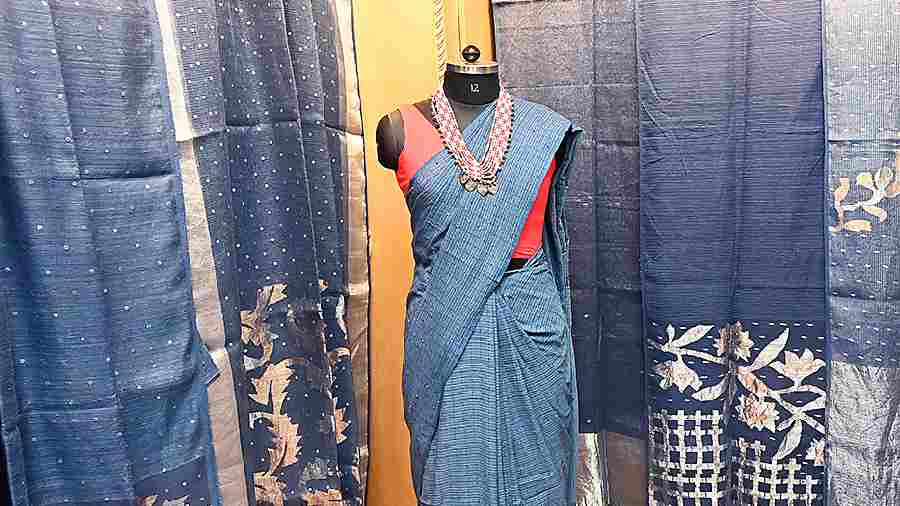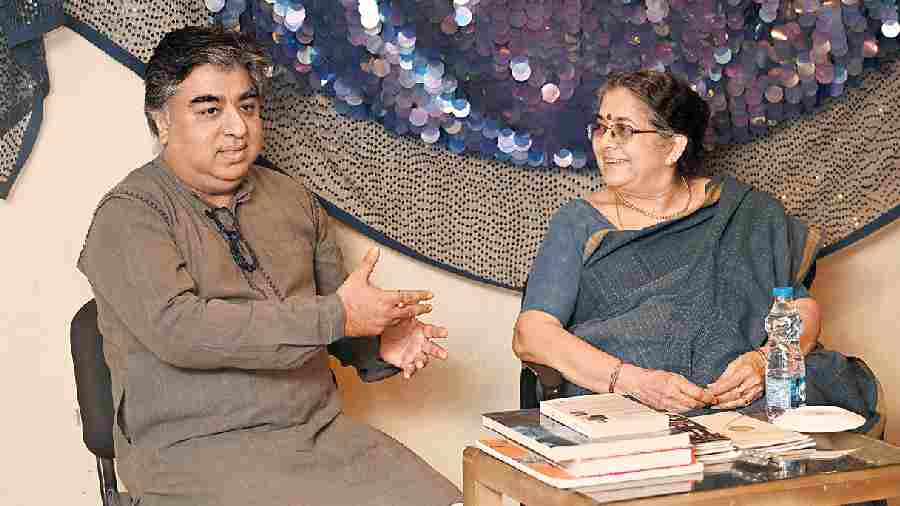Byloom’s Spinning Yarns, a series of talks and exhibitions to celebrate India’s 75th year of Independence, hosted its fourth chapter last month with textile expert Amrita Mukerji. The session was titled ‘Indigo-Following a Blue Trail’, where Mukerji, who prefers to be called a “textile aficionado”, took the listeners through the journey of discovering her passion for textiles and her experience with indigo, leading up to the establishment of Sutra (a not-for-profit society), followed by the project ‘Indigo Sutra’.
Interest in textiles was inculcated at a young age by her mother who collected textiles and her grandmother who worked with kantha. It, however, developed into a passion when as a homemaker, she started travelling with her husband to various places outside India, due to his job requirements, like Singapore, Malaysia, London and Nigeria.
An Affair with ‘George’:
On a trip to London, Mukerji’s curiosity about various Indian textiles took her to The British Museum. “I went to London and that’s when I started learning about textiles. I wanted to see the Indian section but it required a prior appointment of six months. So, I thought I can at least ask them which books to read. A person called Rosemary asked me to wait and finally allowed me half an hour and opened drawer after drawer of various textiles… The lightest jamdanis and muslins…they were probably thinking why is an Indian interested in her own textiles!” she laughed.
She lived in Malaysia followed by Nigeria. “My husband was given a choice of either going to Japan or Nigeria. I chose Nigeria. It was... undiscovered. Japan anybody could go as a tourist, but Nigeria, I don’t know… that was my entry into Africa. We were in Singapore and Malaysia which had colonial connection, but I had no connection to Nigeria, which was exciting and a bit scary. I was so surprised when I went to the streets of Nigeria… what I saw, I recognised it as batik. And, it was in Indonesia that people used to wear it. Then my connection with Africa was batik, my second connection when I went to the stalls was stacks and stacks of checked materials that looked very familiar. There was plain check fabric and designed ones and they called this fabric ‘George’. The gaudy ones were called fancy George. This started my real adventure and I started reading about it. Next time I went to London, I went straight to Rosemary. At that time she wasn’t aware of ‘George’ but later called me to inform me about the research papers she found on ‘George’,” recalled Amrita, while daughter Kanika showed the textile pieces from her collection to the guests.
Her studies showed her how ‘George’ had arrived as a trade item to Nigeria and was connected to the slave trade. “Most of them used to wear these checked clothes. Only the chiefs were allowed to wear it from head to toe and others used to wear it as a wrapper. They used to pick the threads up to do the design. At some point, the government stopped the import of this and then they started making handkerchief size,” said Amrita.
Her research and interaction with people gave her varied information on the moniker of the fabric but it was the beginning of her journey with traded textiles. “I went to my first conference, RMHK (Real Madras Handkerchief) in Madras which connected me to scholars and before going there I was lucky enough to visit the markets of Nigeria where I spotted fascinating indigo-dyed clothes. Anything blue attracts me and I loved the aesthetics that resembled bandhani. They were doing with indigo until they found synthetic dyes and the pattern ingredients were very interesting. I found they did hand drawing also with cassava starch and chicken feather. The mother and daughter used to do it. And some with stencils,” added Amrita.
The birth of SUTRA Textiles:
After 28 years of staying in various places abroad, Amrita came back to Calcutta, where Sutra was established as a not-for-profit society in 2002. “In the meantime, I met many scholars and was very privileged to go to many conferences. Sarawak organised a conference on ikats. Ikats were done by indigenous people there. They used to have competition on who would do best ikats. When I came back I wanted to do that in Calcutta. Not many people would come to Bengal. They would go to Rajasthan but Bengal had so much to offer. In this conference, Thomas Murray took out textiles after textiles. I thought I can’t see this myself. I had to share it. I approached so many but they were apprehensive. I had no connection here except my family. Then in 1998, Darshan Shah, my neighbour, helped me. This was the first time trade textile became the subject of a conference. We thought of doing it as an organisation that would connect India to the world through textiles,” said Amrita.
The journey with the infamous indigo and birth of IndigoSutra:
“I wasn’t chasing after indigo, indigo came to me. I was new to Calcutta after 28 years. I got a call from a lady called Jenny who was coming to Calcutta and someone had asked her to meet me. The reason why she was in Calcutta is because in British library they found a lot of handwritten journals by Thomas Machell. She said she is going to find these indigo houses. I was absolutely thrilled and joined her to take a trail of the indigo houses in Nadia district,” said Amrita.
Next was Amrita’s experiment with an indigo plantation in her new land in Santiniketan. “Charlotte from Vancouver came to Calcutta. I told her I wish I could plant indigo and she asked me why don’t you. I reminded her that in the last 160 years there were no seeds in Bengal. She opened her bag and popped the seeds. I planted them but could do nothing with them. Two boys working with me were very apprehensive as the school book taught them indigo is bad,” added Amrita. However, growing indigo was not a successful affair and she then approached the indigo planters from Tamil Nadu. “I knew people in Tamil Nadu and one of them sent me the seeds and said how to process them. It took 90 days to get the perfect indigo and in 2017 we started Indigosutra,” said Mukerji.

“I am with Byloom from a time when Byloom wasn’t even Byloom. We have worked with indigo extensively. Whatever Bappaditya is doing is fascinating. Amritadi explained it very well. The young generation should know what we are doing with indigo,” said Sonali Gupta, actor

“Through textiles, I explored the whole world... it is an eyeopener to the whole history of the world,” said John Gillow, author and textile expert, while posing with one of Amrita Mukerji’s textile pieces from her collection.

Rumi Biswas and Malavika Banerjee, partners at Byloom.

The indigo collection display at Byloom.







